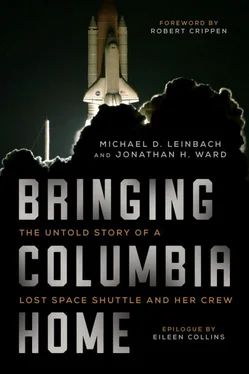Robert Hanley—one of the last people to see Columbia in flight—had been going “stir-crazy” in Houston and was desperately looking for something useful to do. He asked permission to visit KSC and see the reconstruction effort. He only intended to be there part of the day and return on the afternoon flight back to Houston. He walked into the crew module area and saw Pam Melroy writing on a whiteboard. Assuming that he had come to help identify debris, she said, “Robert! Great! How long can you stay?” He replied that he just needed to go back to Houston and get some clothes, and then he could stay as long as she needed his help. He became Melroy’s lead engineer.
Renée Ross was an example of someone brought in for specialized expertise. Ross, a USA employee who managed Columbia ’s flight-data books, received an email from Melroy, asking her help in identifying some fragments of pages that appeared to be from various manuals in the crew module. After a few weeks of exchanging photos of documents via email, Melroy asked Ross to come to KSC to work through the accumulated backlog of crew module document remnants that were being returned from the field. Ross eventually identified and cataloged about four hundred pieces of documentation from Columbia .
Thermal protection system lead engineer Ann Micklos, who had been dating Columbia crewman Dave Brown, received a call from her chief engineer. Micklos recalled, “Knowing my circumstances, he told me, ‘We really need you to be part of the reconstruction crew. You know Columbia ’s systems and you’re the right person to be there. Is this something you think you can do?’ Well, it’s human nature to want to help during a time like this. There was no way I could just sit in my office. Obviously, there was no place I’d rather be than with Columbia , even with how difficult the challenge initially was.”
Finally, some of the “founding fathers”—the original designers of the shuttle at Rockwell International, now a heritage company within Boeing—came to the hangar to help. John Tribe and Sam Kreidel were among the senior Rockwell engineers who had lived with the shuttle since 1972. They knew how the shuttle was originally designed and built.
In contrast, the engineers and technicians from Kennedy knew the current status of the systems and components some twenty-odd years later. There were no digital drawings of most of the shuttle’s components, so the combined knowledge of the designers and the hands-on staff was needed to identify some pieces of debris. [2] Interview with Steve Altemus.
For example, the outboard tires on the left main landing gear could only be specifically identified by the presence of balancing patches that were installed at KSC.
All told, roughly four hundred scientists, engineers, and technicians worked in the hangar during Columbia ’s reconstruction. Most of the workers were from United Space Alliance (who maintained the shuttles at KSC) and Boeing. Nearly every NASA center was represented. [3] NASA, untitled video on lessons learned in Columbia reconstruction with Steve Altemus and Pam Melroy, July 2003 (unreleased).
Operations ran in two shifts per day, six days per week.
—
Several of the people who reconstructed Columbia had also worked with Challenger ’s wreckage following the 1986 accident. Even though the circumstances of the accidents and the reconstruction processes were vastly different, some lessons learned from seventeen years earlier assisted in the Columbia reconstruction.
Challenger fell into the ocean without having left the atmosphere on her mission, traveling a little less than twice the speed of sound at peak velocity during ascent. Despite the way the accident appeared on television, the shuttle stack did not explode. Rather, the vehicle broke up because of aerodynamic forces after the external tank structure failed. Most of Challenger ’s debris—much of it in large chunks and sections—came down in a relatively confined area within sight of the Florida coast.
Columbia , on the other hand, had been traveling in excess of Mach 18 at an altitude of over two hundred thousand feet when it disintegrated. Its wreckage was twisted, shredded, subjected to plasma, melted, oxidized, burned, and scattered over a 250-mile-long path. The vast majority of the debris that came back from Columbia was smaller than an office desk. Much of it was the size of a nickel. [4] Pam Melroy, NASA reconstruction video.
NASA’s primary goals in the Challenger recovery had been to retrieve the crew, the right-hand solid rocket booster (SRB) with the O-ring that had burned through and caused the accident, and the crew module. NASA also was interested in debris from the shuttle’s payloads, the left-hand SRB, the external fuel tank, and a few other specific components. The accident investigation was not focused on the orbiter itself, because the vehicle was clearly not the cause of the accident. There was no need to document the latitude and longitude of where each item was found.
Navy ships and divers spent seven months scouring the sea floor for the priority pieces of Challenger ’s debris. They retrieved 50 percent of the SRBs and less than 50 percent of the orbiter and external tank. [5] Michelle La Vone, “The Space Shuttle Challenger Disaster,” Space Safety Magazine , January 28, 2016, www.spacesafetymagazine.com/space-disasters/challenger-disaster/ .
About 70 percent of the crew module and the surrounding fuselage structure was recovered. [6] Robert Pearlman, “Smithsonian Considering Display of Fallen Shuttles Challenger and Columbia Debris,” collectSPACE.com , January 31, 2011, www.collectspace.com/news/news-013111a.html .
The remains of Challenger ’s astronauts were inside the crew module when it was recovered. The crew compartment had been in the water for more than a month before the navy located it.
Some parts of Challenger unrelated to the accident were left on the seafloor rather than incurring the risk and expense of retrieving them. [7] Interview with John Biegert.
Pieces of Challenger ’s wreckage occasionally wash up on the Florida beach to this day, decades after the accident.
NASA reconstructed parts of Challenger in KSC’s Logistics Facility, about one mile south of the VAB on Contractor Road. I clearly remember it. I was working in design engineering and launchpad safety and structural systems at the time, and I was one of the employees permitted to see the debris during Challenger ’s reconstruction. My first impression was the horrible smell. Challenger reeked of seawater and rotting barnacles. A few of the shuttle stack’s potential failure points were laid out on the floor, including the SRB aft field joint that burned through and the attach point from the SRB to the external tank. A few sizable pieces of the fuselage were propped up using two-by-fours in a rudimentary step toward reconstructing the ship. Much of the smallest debris was basically swept into piles off to one side. The crew module debris reconstruction took place in a small building adjacent to the Logistics Facility, with tightly controlled access.
John Biegert worked as part of the reconstruction teams for both Challenger and Columbia . He said that perhaps the biggest difference he saw between the two efforts was due to the advancement in digital technology over the course of seventeen years. Instead of using Polaroid cameras and the very limited computer technology of 1986 to document the debris, the Columbia accident investigation benefitted from digital photography, three-dimensional scanning and modeling, sophisticated computer databases, and other relatively new technologies.
Читать дальше











